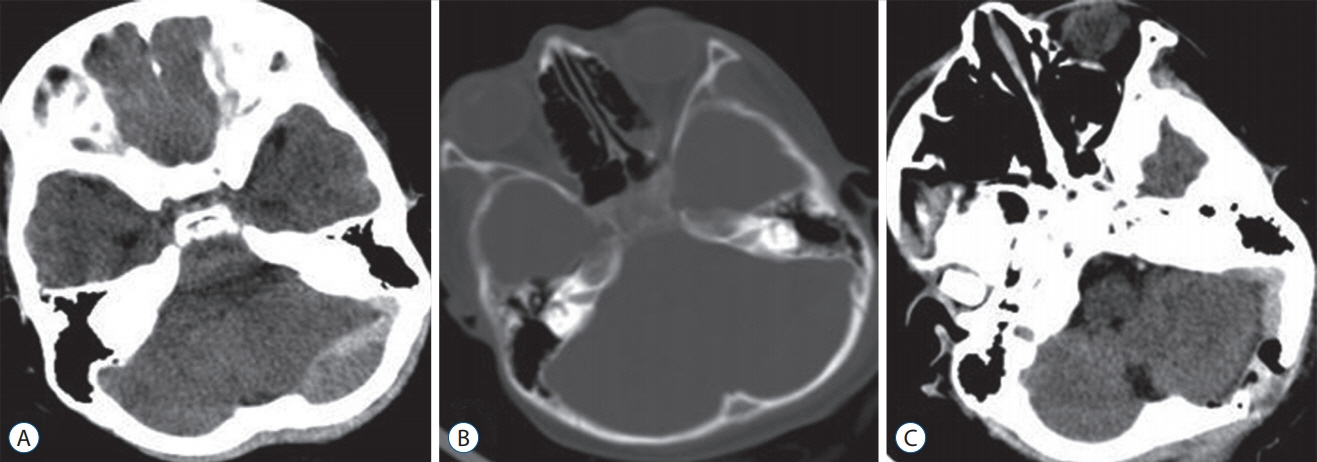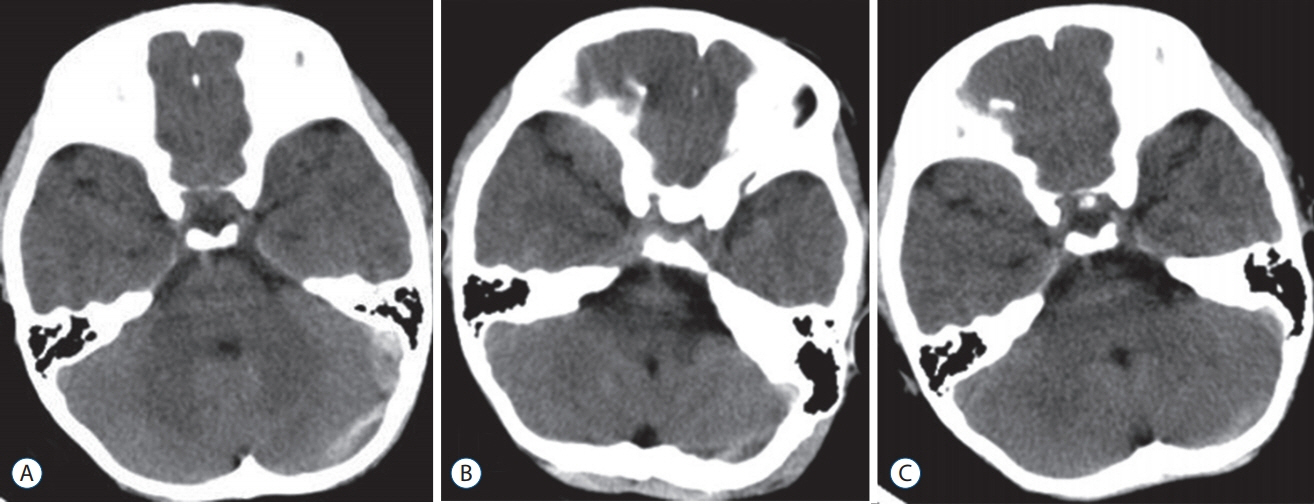J Korean Neurosurg Soc.
2019 Mar;62(2):225-231. 10.3340/jkns.2016.0506.007.
Traumatic Posterior Fossa Epidural Hematomas in Children : Experience with 48 Cases and a Review of the Literature
- Affiliations
-
- 1Department of Neurosurgery, The Second Affiliated Hospital and Yuying Children's Hospital of Wenzhou Medical University, Wenzhou , China. zhangnu63@163.com
- KMID: 2441567
- DOI: http://doi.org/10.3340/jkns.2016.0506.007
Abstract
OBJECTIVE
Epidural haematoma (EDH) most commonly occurs in the supratentorial area, particularly in the temporal region, of the brain. Posterior fossa epidural haematoma (PFEDH) is less frequently observed, accounting for only 1.2% to 12.9% of all EDH cases. Because of the non-specific symptoms and the potential for rapid and fatal deterioration in children, an early computed tomography (CT) scanning is necessary for all suspicious cases. The aim of the present study was to share the experience of 48 cases and review the literature concerning PFEDH.
METHODS
A retrospective analysis was conducted for 48 paediatric cases diagnosed with PFEDH and admitted to Yuying Children's Hospital of Wenzhou Medical University from January 2010 to August 2015. The clinical features and outcomes were analyzed and compared with previous literature.
RESULTS
Seventeen patients were surgically treated in this series and 31 patients received non-operative treatment. The outcomes were good in 46 patients, evaluated using the Glasgow outcome score (GOS), while mild disability was observed in one patient, and only one case showed severe disability. There were no cases of mortality in this series.
CONCLUSION
Posterior fossa epidural haematoma is relatively rare compared with supratentorial epidural haematoma. Early and serial CT scans should be performed for all suspicious cases. The criteria for the surgical treatment of paediatric patients with PFEDH were concluded. The overall prognosis was excellent in paediatric patients.
MeSH Terms
Figure
Reference
-
References
1. Ammirati M, Tomita T. Posterior fossa epidural hematoma during childhood. Neurosurgery. 14:541–544. 1984.
Article2. Berker M, Cataltepe O, Ozcan OE. Traumatic epidural haematoma of the posterior fossa in childhood: 16 new cases and a review of the literature. Br J Neurosurg. 17:226–229. 2003.
Article3. Bor-Seng-Shu E, Aguiar PH, de Almeida Leme RJ, Mandel M, Andrade AF, Marino R Jr. Epidural hematomas of the posterior cranial fossa. Neurosurg Focus. 16:ECP1. 2004.
Article4. Bozbuğa M, Izgi N, Polat G, Gürel I. Posterior fossa epidural hematomas: observations on a series of 73 cases. Neurosurg Rev. 22:34–40. 1999.
Article5. Bullock MR, Chesnut R, Ghajar J, Gordon D, Hartl R, Newell DW, et al. Surgical management of posterior fossa mass lesions. Neurosurgery. 58:S47–S55. discussion Si-Siv. 2006.
Article6. Ciurea AV, Nuteanu L, Simionescu N, Georgescu S. Posterior fossa extradural hematomas in children: report of nine cases. Childs Nerv Syst. 9:224–228. 1993.
Article7. Costa Clara JM, Claramunt E, Ley L, Lafuente J. Traumatic extradural hematomas of the posterior fossa in children. Childs Nerv Syst. 12:145–148. 1996.
Article8. Ersahin Y, Mutluer S. Posterior fossa extradural hematomas in children. Pediatr Neurosurg. 19:31–33. 1993.
Article9. Garza-Mercado R. Extradural hematoma of the posterior cranial fossa. Report of seven cases with survival. J Neurosurg. 59:664–672. 1983.10. Gupta PK, Mahapatra AK, Lad SD. Posterior fossa extradural hematoma. Indian J Pediatr. 69:489–494. 2002.
Article11. Harwood-Nash DC, Hendrick EB, Hudson AR. The significance of skull fractures in children. A study of 1,187 patients. Radiology. 101:151–156. 1971.12. Hooper RS. Extradural haemorrhages of the posterior fossa. Br J Surg. 42:19–26. 1954.13. Jung SW, Kim DW. Our experience with surgically treated epidural hematomas in children. J Korean Neurosurg Soc. 51:215–218. 2012.
Article14. Karasu A, Sabanci PA, Izgi N, Imer M, Sencer A, Cansever T, et al. Traumatic epidural hematomas of the posterior cranial fossa. Surg Neurol. 69:247–251. dicussion 251-252. 2008.
Article15. Lui TN, Lee ST, Chang CN, Cheng WC. Epidural hematomas in the posterior cranial fossa. J Trauma. 34:211–215. 1993.
Article16. Malik NK, Makhdoomi R, Indira B, Shankar S, Sastry K. Posterior fossa extradural hematoma: our experience and review of the literature. Surg Neurol. 68:155–158. discussion 158. 2007.
Article17. Mori K, Handa H, Munemitsu H, Oda Y, Hashimoto N, Kojima M. Epidural hematomas of the posterior fossa in children. Childs Brain. 10:130–140. 1983.
Article18. Neubauer UJ. Extradural haematoma of the posterior fossa. Twelve years experiences with CT-scan. Acta Neurochir (Wien). 87:105–111. 1987.
Article19. Otsuka S, Nakatsu S, Matsumoto S, Sato S, Motozaki T, Ban S, et al. Study on cases with posterior fossa epidural hematoma--clinical features and indications for operation. Neurol Med Chir (Tokyo). 30:24–28. 1990.20. Pozzati E, Tognetti F, Cavallo M, Acciarri N. Extradural hematomas of the posterior cranial fossa. Observations on a series of 32 consecutive cases treated after the introduction of computed tomography scanning. Surg Neurol. 32:300–303. 1989.21. Prasad GL, Gupta DK, Sharma BS, Mahapatra AK. Traumatic pediatric posterior fossa extradural hematomas: a tertiary-care trauma center experience from India. Pediatr Neurosurg. 50:250–256. 2015.
Article22. Roda JM, Giménez D, Pérez-Higueras A, Blázquez MG, Pérez-Alvarez M. Posterior fossa epidural hematomas: a review and synthesis. Surg Neurol. 19:419–424. 1983.
Article23. Sencer A, Aras Y, Akcakaya MO, Goker B, Kiris T, Canbolat AT. Posterior fossa epidural hematomas in children: clinical experience with 40 cases. J Neurosurg Pediatr. 9:139–143. 2012.
Article24. Wang EC, Lim AY, Yeo TT. Traumatic posterior fossa extradural haematomas (PFEDH). Singapore Med J. 39:107–111. 1998.25. Wong CW. The CT criteria for conservative treatment--but under close clinical observation--of posterior fossa epidural haematomas. Acta Neurochir (Wien). 126:124–127. 1994.
Article
- Full Text Links
- Actions
-
Cited
- CITED
-
- Close
- Share
- Similar articles
-
- Traumatic Epidural Hematomas of the Posterior Fossa
- Treatment Results for Traumatic Epidural Hematomas on Posterior Cranial Fossa
- A Study on the Fracture Pattern of Posterior Fossa
- Exploring Rare Traumatic Injuries: A Miniseries of 4 Cases Discussing Epidural Hematomas Bridging the Infratentorial and Supratentorial Regions
- Traumatic Lesions in Posterior Cranial Fossa




